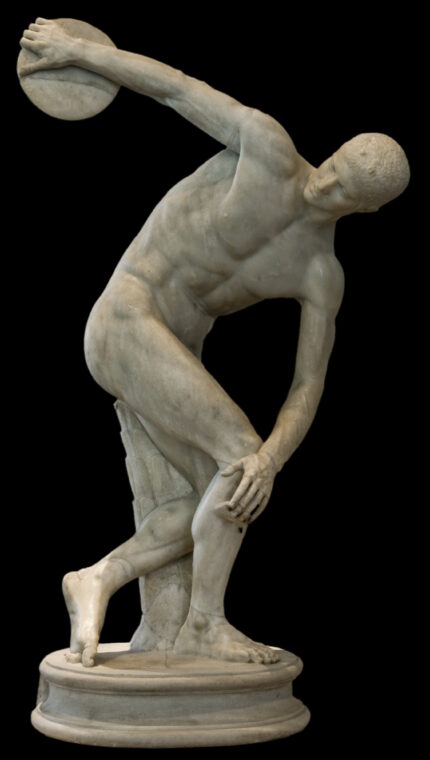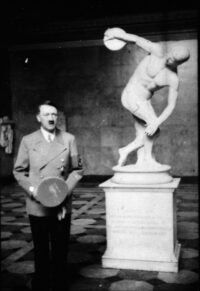
The original was long lost, known only from ancient sources, when the Discobolus Palombara was unearthed. It was the first version of the famous work to be discovered. It is life-sized (many copies are reduced in scale) and is the most complete of any the copies that were later found. It caused an immediate sensation and vaulted into the small club of the greatest surviving works of antiquity.
The sculpture was classified as a work of exceptional national interest by Italy’s 1909 cultural heritage law which made it illegal to export, but in the mid-1930s, the Lancellotti-Massimo branch of the family had financial problems and declared they would sell the Discobolus for the princely sum of eight million lire. The Metropolitan Museum of Art in New York was interested, but ultimately balked at the price.
Hitler was enraptured by Classical Greek art, describing it in Mein Kampf as “the wonderful combination of the most glorious physical beauty with a brilliant mind and the noblest soul.” That harmony was in stark contrast, he believed to the “degenerate” aesthetics of Modernist art. The representation of the heroic male nude was a particular favorite of his as it tied to his ideals of the perfectly fit, strong and muscular Aryan male, trained in sport and war.
The prologue to Leni Riefenstahl’s 1938 Olympia, her influential albeit interminable movie dedicated to the 1936 Olympics, draws the connection between the Classical ideal of beauty and the New German Man explicit. A long montage of the ruins of the Acropolis dissolving into famous Greco-Roman statues, prominently featuring ones in German collections.
The first is the Barberini Faun, which was sold to Ludwig, Crown Prince of Bavaria, in 1827, and has been in the Glyptothek in Munich, built by Ludwig specifically to house his huge collection of Greek and Roman sculpture, since it opened in 1830. Riefenstahl returns to the faun several times. The second is an extreme closeup of the Medusa Rondanini, also collected by Ludwig on his Grand Tour and in the Glyptothek. The Glyptothek’s Braschi Aphrodite makes an appearance, as well.
Then, out of a cloud of dramatic smoke rises the Discobolus who morphs into chiseled German athlete nude in a field throwing a discus into the sun-broken clouds in slow motion. Nude shot-putters, javelin throwers and more discus shots follow, as Riefenstahl claims the inheritance of ancient Greek representations of beauty and athleticism for the Master Race.

Ten years later, it was returned to Italy, one of thousands of artworks stolen, coerced or illegally purchased by the Nazis that were restituted after the war thanks to the diligence of Monuments Men from the Allied armies and national delegates to the task force. Germany strenuously objected to the repatriation of the Discobolus as it had been bought from a willing seller for exorbitant piles of cash, not looted or the product of a forced sale. They took it to the courts repeatedly and went so far as to lodge an official appeal with the President of the United States, Harry Truman. It didn’t work and the Discobolus has been in Italy since November 1948, now in the permanent collection of the National Roman Museum at the Palazzo Massimo.
Amazingly enough, it seems after 75 years, Bavarian museum officials still harbor delusions that their brief, illegal possession of the Discobolus has a chance in Hell of being reinstated.
The dispute arose when the director of the National Roman Museum requested the statue’s 17th Century marble base be returned from the Antikensammlungen state antiquities collection. The German museum instead asked for the return of the Discobolus Palombara, saying it had been illegally transported to Italy in 1948, the Corriere della Sera newspaper reported Friday.
Italy’s culture minister, Gennaro Sangiuliano, expressed doubts that the German culture minister, Claudia Roth, was aware of the Bavarian request.
“Over my dead body. The work absolutely must remain in Italy because it is a national treasure,’’ Sangiuliano was quoted by Corriere as saying, adding that he hoped that the base would be returned.
The fraught history of the Discobolus Palombara was just recently brought to the forefront again when it was featured in the Liberated Art 1937-1947 exhibition at the Scuderie del Quirinale in Rome early this year.
* This article was originally published here






No comments:
Post a Comment